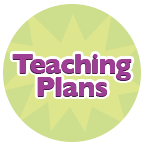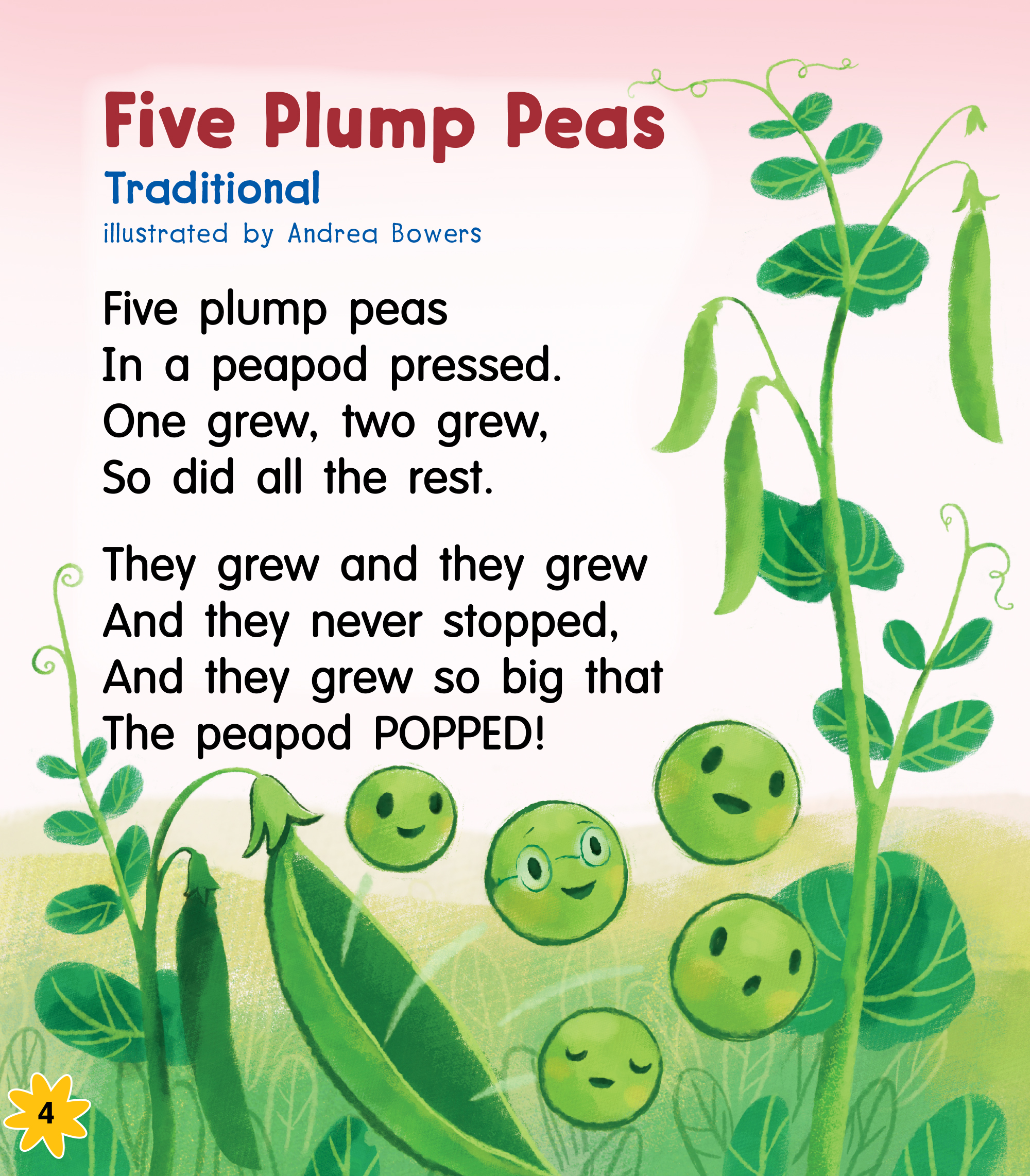Illustrated by Andrea Bowers
Text Type: Fiction: Poetry—nonsense poem
Oral Language Teaching Strategy: Model Eye Contact When Listening Model powerful listening by making eye contact with the person who is speaking to you.
Time: 20 minutes
Materials:
– All Together Now, page 4
– real or toy peapod(s)
– Media Key or Online: “Five Plump Peas” audio
Grouping: whole class and partners
Assessment: Kindergarten Oral Language Assessment Scale See especially the section on Phonological and Phonemic Awareness.
FIRST READING
BEFORE READING
- Show the students the illustration that accompanies the poem.
- Tell students that they are going to read a poem about what happens to some peas growing in a garden.
Activating and Building Background Knowledge
- Ask students to describe the illustration accompanying the poem and prompt, as needed, to elicit vocabulary, such as ‘peas,’ ‘peapods,’ ‘vegetable,’ ‘growing,’ ‘garden.’
-
Have you ever eaten peas out of a peapod? What did they taste like? How did they look compared to the peas in the illustration?
Invite students to share what they know about peas and peapods. Some students may have planted, grown, and eaten their own peas, others may only be familiar with frozen peas, canned peas, snap peas, or snow peas.
- Give a real or toy peapod, or a few pre-cooked peas, to each student or have students pass it around. Ask the students to describe the look, feel, and taste of the peas to an elbow partner. Encourage students to maintain eye contact with their partner as they listen. Explain that making eye contact helps listeners pay attention to and understand what the speaker is saying.
Setting a Purpose
- Explain that you’re going to read the poem to them and, as they listen, they should think about what made the peapod pop. [Making connections/inferring]
DURING READING
- Read the poem to the class, tracking the print, then invite students to join in as you reread the poem.
- Focus on comprehension by offering prompts:
- How many peas are in the pod that’s popped? [Analyzing]
- What do you think the word ‘plump’ means? [Inferring/making connections]
- Why do you think the other peapods hanging on the plant haven’t popped yet? [Inferring/making connections]
-
Justin… Jus-tin… I’m hearing two sounds beat there… Jus- (clap) tin (clap): Now let’s try ‘Jade.’ How many claps do we need for ‘Jade’? Now let’s try clapping the syllables of the words in the poem. (Phonological Awareness)
Play the fluent reading of “Five Plump Peas.” As the narration unfolds, model clapping once for each word, while pointing to the words. Invite the students to join in clapping. Then, model clapping to match each syllable (e.g., one clap for one-syllable words, such as ‘five’ and ‘plump,’ and two claps for two-syllable words, such as ‘peapod’ and ‘never’). Before replaying the fluent reading, you may wish to demonstrate the number of claps needed for single- and double-syllable words, using students’ names to engage students.
- Replay the recording on the Media Key or online and encourage the students to clap along as they join in with you and the narrator.
Adding Playful Movements
- Narrate the entire poem and demonstrate the actions that accompany the text:
- Five plump peas in a peapod pressed
Make a fist with one hand with the thumb on top, and clasp fist with the other hand, thumb over thumb.
- One grew, two grew, so did all the rest.
Two by two, stick out both pointer fingers, then other pairs of fingers until hands are palm to palm with all fingers spread out.
- They grew and they grew and they never stopped.
Draw hands apart to show how the pod is growing, as you might do to show how big something is.
- And they grew so big that the peapod POPPED!
Loudly clap hands together as you say the word “POPPED.” - Teach the actions, part by part, asking the students to demonstrate the hand movements they’ve learned for each part of the poem. Then invite students to practise performing the actions as they chant the poem along with you or the recording.
AFTER READING
-
Before we read the poem, I asked you to listen to think about what made the peapod pop. Why do you think it popped?
Revisit the purpose for reading by asking the students to suggest what made the peapod pop. [Inferring/making connections]
- You may wish to conclude the lesson with everyone chanting the poem as they do the hand actions.
SECOND AND FURTHER READING
The students will want to reread “Five Plump Peas.” During further lessons, consider including a balance of ideas from the following areas:
Engaging in Playful Language Activities
- Place students into groups of five (you may need to group and then regroup the students, so that all may participate). Have students crouch down next to each other as though they are peas in a peapod. As you read the poem or play the fluent reading, have students pretend they are the peas and act out the unfolding action. First students can crouch close together, slowly rising and expanding as they grow, then they finally hop away from each other as the peapod pops. Once students are familiar with the actions, ask them to perform them as they chant the poem.
-
I’m going to pretend I’m one of these peas and I’m saying “It’s getting pretty tight in here. I can’t wait to get out so I can bounce around to see what’s happening in the world outside our peapod house!”
Ask students to imagine that they are one of the peas growing in the peapod, and that the pea can talk. Encourage students to imagine what the peas might say and how they might feel inside and outside of the peapod. Have students turn to their elbow partners and talk, pretending they are peas.
Extending Comprehension
-
As I play the recording, listen and try out your new actions with your partner. I’ll play it a few more times so that you can practise, then you can show them to the rest of the class. (Making connections)
Ask students to join an elbow partner to think of different actions they could use to match the action words in the poem (e.g., ‘pressed,’ ‘grew,’ ‘popped’). Tell students they may use their fingers, hands, or entire bodies to do the actions.
- Ask students to each take a puppet from the puppet collection. Invite them to use their puppet to have a conversation with an elbow partner’s puppet about growing or eating peas or another vegetable. Remind students to keep in character as they discuss (e.g., Chicken: “My Mom wants to grow peas instead of wheat this year.” Dog: “Well, I’ll help Little Red Hen look after those peas.”)
- Display the digital cloze version of the text on the Media Key. Working with the whole class, or with a small group, reread together and encourage students to supply the missing words (spaces for words highlighted in yellow). You may decide to pause to consider word predictions and prompt, “Does that make sense?” or “Does that sound right?” Then click on the colour-highlighted spot to reveal the word, saying, “Let’s check that out.” An option on the tool bar allows you to create your own cloze versions of the text to meet the needs of the students you are working with. Click on the ‘Help’ button to find out how to use the different features of the digital texts.
Developing Phonological Awareness
- Ask students to name all of the words in “Five Plump Peas” that begin with the letter ‘p’ (‘plump,’ ‘peas,’ ‘peapod,’ ‘pressed,’ ‘popped’). Invite them to join an elbow partner to think of other words that begin with the letter ‘p,’ then to share those words with the whole class. Remind students to maintain eye contact with partners and other class members when they are speaking and listening.
- Using the phrase ‘plump peas’ as inspiration, encourage students to think of other words to describe food items that begin with the same letter as the name of the food (e.g., crunchy carrots, leafy lettuce, mighty meatballs).
Enriching Print Concepts
- Track the print as you read and reread the poem, emphasizing the movement from the end of one line to the beginning of the next. Invite students to take turns tracking the print as they become more familiar with the text.
-
Think about how you used your hands to show those peas growing. How could the poet have written the words on the page to show that the peas were growing?
Explain that the word ‘POPPED’ is in capital letters to place emphasis on the word, so that it is read louder and more expressively. Reread the poem with students, together looking for other words that could be emphasized in the same way. To assist in finding words to emphasize, you may wish to have students do the actions and think about which words the actions are emphasizing (e.g., “They GREW and they GREW and they never stopped.”). Write out the revised text for students so that they can view the emphasis placed on the words.
FOLLOW-UP IN CENTRES
- Place the big book at a centre and encourage students to reread the poem by tracking along the lines of print, or performing the actions they have learned or invented. Students may use the fluent reading to support their own reading if needed.
- Place illustrated books and poems about gardens and growing things in the library corner so that students can explore or revisit their contents. Include audio, if available, to support student reading. Consider books such as Hair Heads from Literacy Place for the Early Years Kindergarten Shared Reading, The Carrot Seed by Ruth Krauss, The Enormous Turnip by Alexei Tolstoy, Jack and the Beanstalk by various authors, and poems and songs such as “The Garden Song.”
- If you have already introduced the students to the growing techniques in Literacy Place for the Early Years’ Hair Heads, consider providing materials for students to grow other easy-to-grow plants, such as beans or nasturtiums.
- Students may work independently or in small groups to use any of the puppets to create, practise, and perform a short puppet play about growing food or plants.

